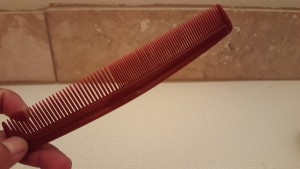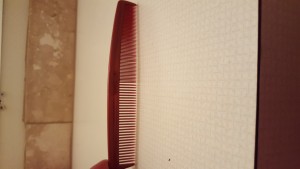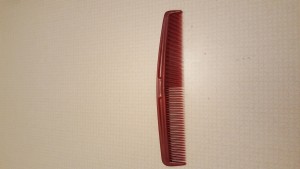Hey y’all! I decided to choose the comb from amongst the other items in my bathroom. Here is my Prownian analysis.
Description: The object is of a red color. There are fine teeth-like parts on the object. These “teeth” are evenly spaced and pointy at the ends. It is about 6 or 7 inches in length and is made out of some sort of plastic.
Deduction: It looks like the object is used by an individual, but many individuals may use it. The object can be used by men, women, or children. The object is located in the bathroom primarily. The object’s purpose is to fix or arrange messy hair into a more neatly manner. The person who uses this object cares about their appearance, which makes sense because the object can enhance the appearance.
Speculation: Anybody who uses this object probably cares about their appearance and what their hair looks like. The producer of this product chose to use plastic, does this mean that the producer doesn’t care about their impact on the environment? Does the consumer of this product make a good decision to buy a plastic, rather than a wooden, ceramic, etc. , version of this object? Is it cheaper or easier to mass produce this object with plastic, rather than a more decomposable material?
Open Web source:
Freinkel, Susan. “A Brief History of Plastic’s Conquest of the World.” Scientific American. May 29, 2011. http://www.scientificamerican.com/article/a-brief-history-of-plastic-world-conquest/.
Combs are one of the oldest tools and are/have been used by humans across many different cultures for detangling, decoration, and delousing of the hair. Amongst every other beauty/health and hygiene product, the comb has not changed very much other than the material used to make it.
Peer-Reviewed Source:
Kardash, O. V., and T. M. Ponomareva. 2012. “MEDIEVAL (9TH-13TH CENTURY) COMBS FROM NORTHWESTERN SIBERIA.” Archaeology, Ethnology & Anthropology Of Eurasia (Elsevier Science) 40, no. 2: 72-82. Academic Search Premier, EBSCOhost (accessed January 26, 2016).
Until the 13th Century, the native peoples of Northwestern Siberia used mostly unilateral combs made from bone or a single piece of wood. These medieval unilateral combs were not only used for hygiene but also as elements of “coiffure” and amulets.
I’m going to use the first web source to expand on the author’s method of understanding the object. The author looks at how the object came to be, how it was made as a hand tool, how people from the past would know exactly what to do with a present-day comb, and how it was not only used for hygiene, but also for decoration in the hair. The author talks about the shape, practicality, versatility, and other aspects of the comb, which compares to Prown’s methods in a way.


I enjoyed your article and found your speculation /questions all very interesting. I think if there were other options besides plastic that consumers would buy a comb no matter what it was made out of.
I also enjoyed the history on the comb from your peer reviewed source.
Thanks!
Thank you Karina. That is true, they probably would. Thank you, I found it interesting too. Pete
Your post was really informational. I enjoyed the part on the history of the comb being made from bone or wood. I also liked your speculation on some one potentially not caring about the environment by using some thing made of plastic. I don’t think I would have even thought about making that speculation, but its a great one.
Thank you Lindsay. I know it was interesting thought that I had because it is true. It’s another contribution that most people probably wouldn’t think about. Thank you for your comment. Pete